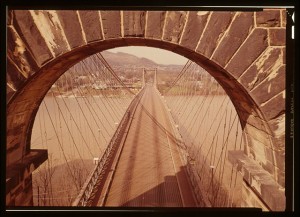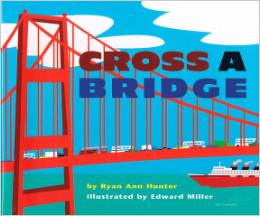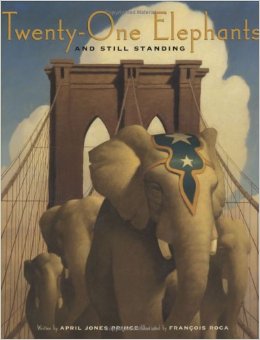Kindergarten students will begin work in the science lab with Mrs. Levine exploring the science unit, The Materials in Our World. The unit will provide opportunities for students to observe and compare the properties of a variety of kinds of wood, paper, fabric, and earth materials. Hands-on activities allowed students to discover what happens when they subject the materials to a number of tests and interactions.
As active learners, students will apply their science knowledge to the exploration of primary sources and bridges!
During a series of library lessons, the students will become familiar with primary sources. The primary sources will include video and images of bridges.
 The above image, Wheeling Suspension Bridge, Spanning East channel of Ohio River at U.S. Route 40, Wheeling, Ohio County, WV will be revealed as tiles are removed. Students will be guided through the analysis of the the document using the protocol, “Observe.Reflect.Question.”
The above image, Wheeling Suspension Bridge, Spanning East channel of Ohio River at U.S. Route 40, Wheeling, Ohio County, WV will be revealed as tiles are removed. Students will be guided through the analysis of the the document using the protocol, “Observe.Reflect.Question.”
Students will identify and note details.
What do you notice first? · Find something small but interesting. · What do you notice that you didn’t expect? · What do you notice that you can’t explain? · What do you notice now that you didn’t earlier?
Students will generate and test hypotheses about the source.
Where do you think this came from? · Why do you think somebody made this? · What do you think was happening when this was made? · Who do you think was the audience for this item? · What tool was used to create this? · Why do you think this item is important? · If someone made this today, what would be different? · What can you learn from examining this?
Students ask questions to lead to more observations and reflections.
What do you wonder about… who? · what? · when? · where? · why? · how?
 Read: Cross a Bridge by Ryan Ann Hunter, illustrated by Edward Miller. This very simple introduction to bridges explains what bridges old and new are made of, how they first came to be of use, all the different types of bridges there are (pontoon, covered, suspension, etc.) and the distances they cross.
Read: Cross a Bridge by Ryan Ann Hunter, illustrated by Edward Miller. This very simple introduction to bridges explains what bridges old and new are made of, how they first came to be of use, all the different types of bridges there are (pontoon, covered, suspension, etc.) and the distances they cross.
When the Brooklyn Bridge was opened, its span across the East River in New York was the longest in the world, and its two stone landings were the tallest structures in North America. Designed by John Roebling and completed by his son and daughter-in-law Washington and Emily Roebling, the bridge stirred controversy over its cost, size, safety, and even its very necessity.
Watch this short video from the Library of Congress showing the entire trip from Brooklyn to New York in 1899.
As students identify questions appropriate for further investigation, a research strategy will be developed to help them find answers.
Read: Twenty-One Elephants and Still Standing by April Jones Prince, illustrated by Francois Roca
After fourteen years of construction, the Brooklyn Bridge was completed, much to the delight of the sister cities it connected: Brooklyn and New York City.
Fireworks and top hats filled the air in celebration when the magnificent bridge opened in 1883. But some wondered just how much weight the new bridge could hold. Was it truly safe?
One man seized the opportunity to show people in Brooklyn, New York and the world that the Brooklyn Bridge was in fact strong enough to hold even the heaviest of passengers. P. T. Barnum, creator of “The Greatest Show on Earth,” would present a show too big for the Big Top and too wondrous to forget.
 Exploring the iPad App Bridge constructor will become an appraised bridge engineer and architect! They will create and design their own constructions and watch the cars and trucks pass over them – or see them fall and crash while the inferior creations collapse due to weight and the laws of physics!
Exploring the iPad App Bridge constructor will become an appraised bridge engineer and architect! They will create and design their own constructions and watch the cars and trucks pass over them – or see them fall and crash while the inferior creations collapse due to weight and the laws of physics!

